|
The
|
||||||||||||||||||||||||||||||||||
THE BURGENLAND BUNCH NEWS - No. 226 November 30, 2012, © 2012 by The Burgenland Bunch All rights reserved. Permission to copy excerpts granted if credit is provided. Editor: Thomas Steichen (email: tj.steichen@comcast.net) Our 16th Year. The Burgenland Bunch Newsletter is issued monthly online. It was founded by Gerald Berghold (who retired Summer 2008 and died in August 2008). |
||||||||||||||||||||||||||||||||||
Current Status Of The BB: * Members: 2109 * Surname Entries: 7073 * Query Board Entries: 5046 * Staff Members: 17 |
||||||||||||||||||||||||||||||||||
This newsletter concerns: 1) THE PRESIDENT'S CORNER 2) JUSTICE IN ACADEMIA REVISITED 3) A VILLAGE-NAMING CONVENTION 4) SOPRON, HUNGARY 5) HUNGARIAN TRANSLATIONS 6) HISTORICAL BB NEWSLETTER ARTICLES: AT THAT TIME - GROßHÖFLEIN 100 YEARS AGO (by Matthias Artner) 7) ETHNIC EVENTS 8) BURGENLAND EMIGRANT OBITUARIES (courtesy of Bob Strauch) |
||||||||||||||||||||||||||||||||||
1) THE PRESIDENT'S CORNER (by Tom Steichen)  Concerning
this newsletter, we start with a follow-up on Ilse Nusbaum's Quest to have her Father
awarded a Posthumous Doctorate Degree by the Vienna University of Economics and
Business, a quest that proves successful, though not in the way she hoped for. We follow that
with an article about an internal staff discussion concerning a Convention on How to
Reference Village Names. The third article continues my look at border villages, this
time Sopron, Hungary. The fourth article features Joe Jarfas, who has been a
major help in getting accurate Translations of Hungarian text;
thanks Joe! Concerning
this newsletter, we start with a follow-up on Ilse Nusbaum's Quest to have her Father
awarded a Posthumous Doctorate Degree by the Vienna University of Economics and
Business, a quest that proves successful, though not in the way she hoped for. We follow that
with an article about an internal staff discussion concerning a Convention on How to
Reference Village Names. The third article continues my look at border villages, this
time Sopron, Hungary. The fourth article features Joe Jarfas, who has been a
major help in getting accurate Translations of Hungarian text;
thanks Joe!The remaining articles are our standard sections: Historical Newsletter Articles, and the Ethnic Events and Emigrant Obituaries sections. Although I seldom comment on the obituaries, this month we list two that warrant special comment due to the influence the deceased had on our shared heritage. Rose Schanter, as her obit notes, was co-owner, along with her husband Hans Schanter and brother Steve Deutsch, of the Castle Harbour Casino in The Bronx, NY, from 1961 to the mid 1990’s. The Casino was a gathering place for Burgenländers for over 75 years but closed its doors in the fall of 2005. It was, as Frank Paukowits noted when it closed, "...the most popular place for dances and 'Hochzeiten' for many of the Burgenländers who lived in the NYC metropolitan area. Countless German songs were sung and beer glasses lifted over the years... not only were functions held on weekends, but on weekdays the restaurant operation was bustling. The food was great with Rosie Schanter, Steve’s sister, in the kitchen. The place was always filled to capacity." Frank called the Casino closing the "end of an era" and, now with Rose, brother Steve and husband Hans all passed, that era is truly over. Wilhelm Fiedler, an ethnic German from Sopron, Hungary, was equally influential in strengthening the German-American ethnic community of Toledo, Ohio. For 35 years, he was president of the Greater Beneficial Union's District #510 and was a founding father of Toledo's German-American Festival Society, putting his masonry skills to work to help construct the festival's permanent grounds and his leadership skills to use as a multi-year chairman of the event. Through his efforts over many years, he helped strengthen the foundations of Toledo's German-American heritage, both literally and figuratively. 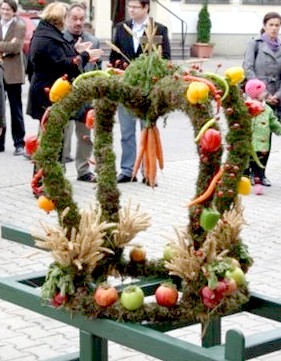 AUSTRIAN
"THANKSGIVING"—ERNTEDANKFEST: The recent passage of the
annual American Thanksgiving holiday (which also, in its way, celebrates immigration) made me
ponder what the equivalent Austrian celebration was. Undoubtedly, there would be "harvest"
festival of some sort and, indeed, there is: the Erntedankfest. AUSTRIAN
"THANKSGIVING"—ERNTEDANKFEST: The recent passage of the
annual American Thanksgiving holiday (which also, in its way, celebrates immigration) made me
ponder what the equivalent Austrian celebration was. Undoubtedly, there would be "harvest"
festival of some sort and, indeed, there is: the Erntedankfest.Erntedankfest typically takes place on a Sunday during autumn right after the harvest, generally in October. Compared to the American Thanksgiving, it is more a communal event rather than one celebrated at home. The festivities begin in church with a sermon, singing and a blessing of selections from the abundance of the harvest and, most importantly, the blessing of the harvest crown (Erntekrone). This is followed by a procession and the presentation of the crown to the harvest queen (Erntekönigin), with music and a "country fair" atmosphere. After that there is, of course, lots of eating, drinking and dancing. Everyone often ends up at the Wirtshaus, the local pub, for some beer, schnapps and hearty food. Popular Erntedank dishes include pumpkin soup, roast pork, duck, goose, lamb and game, which is in season during this time of the year. In some places, there is also an evening service followed by a lantern and torch parade (Laternenumzug) for the children—and even fireworks!  It sounds like lots of fun ...but there is something positive to be said about the American version too; being surrounded by family, enjoying a (too) sumptuous meal, and watching a few football games or parades (or playing or being in your own), has its merits. So, Happy Thanksgiving everyone! DIGITAL CHURCH BOOKS: BB member Thomas Seltsam, of Vienna, Austria, wrote to share some websites. He said: 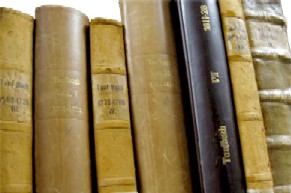 Dear
Mr. Steichen, as some of the members of BB may also have relatives in other parts of the
former K.u.K. monarchy I would like to recommend the following homepages: Dear
Mr. Steichen, as some of the members of BB may also have relatives in other parts of the
former K.u.K. monarchy I would like to recommend the following homepages:http://matricula-online.eu/?lang=en - The site contains digitized church books of nowadays Lower Austria, Upper Austria and Vienna. The number of books is steadily increasing. Some of them are surprisingly easy to read and if available also the indices were scanned and published. As mentioned in the current newsletter you can not view data which is younger than a hundred years. http://actapublica.eu/ - This site has the digitized church books of some parts of nowadays Czech Republic and some parts of nowadays Lower Austria. They also scanned available indices. On clicking the magnifier to the top left you come to the search site. On top you can choose the region in the first field you can enter the name of the village. With kind regards, Thomas Seltsam, Vienna, Austria I was aware of the first of these two sites but, when I last looked at it, there were not many records available. However, as Thomas said, "the number of books is steadily increasing" and, if your research take you elsewhere in Eastern Austria, this may now be a quite useful resource. The other site is new to me. Being it covers areas in the Czech Republic adjacent to Austria, it may also prove useful to some of our members. Both sites have been added to our URL/Links page. My thanks to Thomas for sharing these links with us! 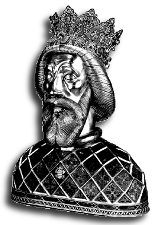 MORE
DIGITAL CHURCH BOOKS: In another note, László Békési wrote to say: MORE
DIGITAL CHURCH BOOKS: In another note, László Békési wrote to say:Hello Tom, good news for researchers: the parish books of diocese Györ are available on-line at http://www.gyeleveltar.hu/. Registration, costs: http://www.gyeleveltar.hu/?q=content/regisztracios-adatlap. The presently uploaded villages: http://www.gyeleveltar.hu/?q=node/9. Hope it helps a lot of us. Best regards, László B. This is, indeed, good news for BB researchers, especially those of the northern areas of Burgenland, as this is the region to the west and south of Neusiedl and many of our researchers thereof reference Györ diocese villages as being of ancestral interest (me included). As László implies, not all of the Catholic parishes of Györ Diocese are currently uploaded (but many are). I have printed the list of currently available villages below, bolding those that I know are referenced by our members (perhaps more are referenced, but those bolded are the ones I can recall without looking). Available parishes: Abda, Agyagosszergény, Ásványráró, Ászár, Babót, Bágyogszovát, Bakonysárkány, Balf, Bana, Beled, Bezenye, Bogyoszló, Bo, Csapod, Császár, Csepregi Esperesi Kerület, Dunaalmás, Dunaszeg, Dunaszentpál, Egyházasfalu (Keresztény), Farád, Fehértó, Fertoboz, Fertoendréd, Fertoszéplak (Sarród), Gyömöre, Gyor-Belváros, Gyor-Káptalandomb, Gyor-Nádorváros, Gyor-Révfalu, Gyor-Szabadhegy (Kismegyer, Kölestó, Sashegy), Gyor-Sziget, Gyor-Újváros, Gyorsövényház, Gyorszemere, Gyorújbarát I (Kisbarát), Gyorújbarát II (Nagybarát), Gyorzámoly, Halászi, Hegyeshalom, Hidegség (Fertohomok), Iván, Jánossomorja I (Mosonszentjános), Jánossomorja II (Mosonszentpéter), Jánossomorja III (Pusztasomorja), Kajárpéc, Kapuvár, Kisbér, Kocs, Kóny, Kópháza, Kunsziget, Lébény, Levél, Magyarkeresztúr, Markotabödöge, Mecsér, Mihályi, Mocsa, Mosonmagyaróvár I (Magyaróvár), Mosonmagyaróvár II (Moson), Mosonszentmiklós, Nagybajcs, Nagycenk, Nagylózs, Nemesládony, Nyúl, Osli, Öttevény, Páli, Peresznye, Pereszteg, Rábaszentmihály, Rábatamási (Sopronnémeti, Jobaháza), Répceszemere, Répcevis, Röjtökmuzsaj, Sajtoskál, Sopron-Szent György Plébánia, Sopronhorpács, Sopronkövesd, Szakony, Szákszend, Szomód, Szony, Tata, Tényo (Sokorópátka), Tét, Veszkény, Vitnyéd, Völcsej. Note that: 1) villages in parentheses above are subsets of the prior-listed village; or 2) are previous villages now part of a merged, renamed village; and 3) the names after Gyor- are the districts/parishes of Györ (at least, those are my best guesses of what the notation means). While the LDS has microfilmed records for many of these parishes for the ~1828-1921 time period, the images being made available by the Diocese span a much wider era. Most parishes go back to the early 1700s (some to the early 1600s) and go forward to ~1950 (some to ~2000). This is a wealth of information! The bad news... it's not free: The Diocese requires registration and the paying of fees... 10 Euros get you 15 days access and the right to download 15 images; 20 Euros is good for 3 months and 50 images; 60 Euros get you 1 year and 200 images. Having read the page about fees László listed above, it does not seem that they have considered a "dollar" or other non-European Union option yet, so paying the fee appears to be awkward for Americans and other outlanders. While I'm never happy about paying fees, 60€ is a lot cheaper than a flight to Europe and an extended stay in Györ to do research (though such a trip could be fun! ...the Archive address is Egyházmegyei Levéltár, 9021 Györ, Káptalandomb 5/a.). Also note that the registration seems somewhat excessively intrusive, asking for things like your mother's name and your place and date of birth (I suspect this is to allow some access to the more recent data, however, they require this even if you only want to look at old data). I'm interested in learning more about the difficulties (or not) of access to and use of these records so, if you try it out, please write with a report for our membership; I'm sure there are many who would like to know more. HAPPY ANNIVERSARY, KLAUS: It was 10 years ago, in November 2002, that Klaus Gerger was asked by Dr. Dujmovits to join the Burgenländische Gemeinschaft staff as BG Liaison to the BB. He has since served both organizations well in that role (as well as his BB roles as Vice President and Burgenland, Houselists and Maps Editors. My congratulations and thanks to Klaus for a great 10 years as Liaison and for all he does on behalf of the BB and BG. FYI, Klaus had been a member of the BB staff since July 2000, being proclaimed by Gerry Berghold at the time Klaus joined the staff as "well known as an unofficial ambassador of the Güssing area and southern Burgenland." It seems Dr. Dujmovits recognized this too ...and turned him into an official ambassador! 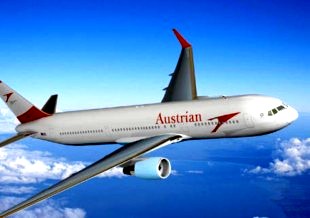 AIR
TRAVEL: Margaret Kaiser passed along word of some new direct flights between Vienna
and Chicago's O'Hare airport. AIR
TRAVEL: Margaret Kaiser passed along word of some new direct flights between Vienna
and Chicago's O'Hare airport. Austrian Airlines will provide five Boeing 767 round-trip flights per week beginning mid-May 2013, increasing their total to 26 weekly North American flights (the other are Boeing 777 flights to New York and Boeing 767 flights to Washington, DC, and Toronto, Canada). The article in the online Pannonien Tivi Ferien Magazin (http://pannonien.tv/auf-nach-chicago/2012/) makes note that the flights may be of special interest to Burgenländers, particularly "...the 30,000 'Former' living in the third largest city in the USA." ST. JOSEPH COUNTY, INDIANA (SOUTH BEND) OBITUARY INDEX: Margaret Kaiser also passed along word of a new online obituary index database provided by the St Joseph County Public Library that covers all of St. Joseph County, Indiana, home to South Bend, Indiana. I did a quick look at it and noted that the database indexes over 236,000 obituaries that appeared in the South Bend Tribune from 1913 to the present. It is being continuously updated with new or missing obituaries. The online search facility returns record listings like the following:
If you click on a particular returned record, you get a slightly more expanded index, like this:
The actual obituaries are not online but can be viewed at the Library. Alternatively, the
Library staff can access, copy and mail obituaries (or do other genealogical research) for an
hourly fee (currently a reasonable $10/hour with a $5 minimum, even if they find nothing;
copying and postage included free). They note that they can typically process 10
obituaries/hour, so bundle multiple requests together if you have such. |
||||||||||||||||||||||||||||||||||
2) JUSTICE IN ACADEMIA REVISITED In Newsletter 214 (October 31, 2011), BB member Ilse Nusbaum wrote about "My 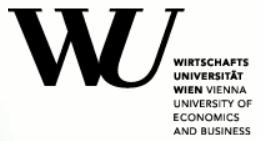 Justice
in Academia Week in Austria," her quest to have the Wirtschaftsuniversität Wien (Vienna
University of Economics and Business) award, posthumously, her father's Doctorate degree,
which he expected to receive in June 1938 (the school was known then as Hochschule für
Welthandel, the University for World Trade). However, the family was expelled by
the Nazi's and fled to America in May 1938, as she says," among the fortunate few." Justice
in Academia Week in Austria," her quest to have the Wirtschaftsuniversität Wien (Vienna
University of Economics and Business) award, posthumously, her father's Doctorate degree,
which he expected to receive in June 1938 (the school was known then as Hochschule für
Welthandel, the University for World Trade). However, the family was expelled by
the Nazi's and fled to America in May 1938, as she says," among the fortunate few." Her father, Karl Lowy, was a teacher at the commercial college in Eisenstadt, working on his advanced degrees when he could. He had received his Diplomkaufmann (Master of Business Administration) degree from the university and had completed his doctoral studies in March 1938, with his dissertation accepted January 21, 1938. Ilse visited the University and was able to obtain a copy of the dissertation (preserved in the University library), and his record book, which indicated that he had passed all his exams and that his dissertation had been accepted and approved. However, the dissertation was unsigned and lacked the university stamp with the Austrian coat of arms (which appeared on the backs of the title pages of dissertations submitted before the Anschluss). Instead, her father’s dissertation had only the university stamp, one with a swastika. In her article, Ilse said her "desire to have my father honored with a posthumous degree was met with respect. It's my understanding that my request will be looked into, perhaps in November." Here we are a year later... and Ilse has good news... she wrote to say: "...my Quest for Justice ended in an unexpected way. The Vienna University of Economics (WU) provosts studied my request and decided that, although they couldn't give my father a posthumous doctorate, this coming spring they will honor all the scholars in the same situation with a ceremony and plaque. The date hasn't been decided yet, but I'm invited to attend. It wasn't the hoped for outcome, but is even better, in that it's more inclusive. I will be there." Here is the message from the provosts: Thank you very much for your patience since your last visit to the WU. The Rector’s Council has given due consideration to your father’s case and those of other students who were in a similar situation in 1938. We have also made inquiries about the legal situation of awarding your father with a posthumous degree. Unfortunately, the Austrian University Law does not permit a formal doctoral degree in this specific case because the two final exams („rigorosen“), the viva voces, were not taken. These are oral exams in which the student answers questions posed by an examiner on their written dissertation and are an integral part of a doctoral study at the WU. Clearly, it was not your father’s fault that he missed these exams but, according to law, these requirements had to be met in order to complete the doctorate. Having said this, the Rector’s Council very much appreciates your efforts to obtain recognition for the families of those of our students who were unable to finish their studies during 1938. We have therefore decided to fund a research project to record the persons and document the circumstances that led to the unforeseen end of many academic careers. To disseminate the results of the study and to officially express our sympathies towards those affected by the inhumane and wrongful events of that time we will have an academic ceremony on campus in spring 2013. This event will be to commemorate the students and faculty involved in this and in similar cases. A plaque listing those students who were forced to discontinue their studies in 1938 will be unveiled and your father’s name will be explicitly mentioned on it. We would respectfully like to invite you to the unveiling and the commemoration ceremony. In this way we hope to show that we are more than willing to acknowledge the wrong that was done to your father and so many other students during that time. We would be delighted to meet you in person and welcome you as a guest at the academic ceremony. Ilse says, "Upon reflection, I prefer this result." (She also offered to tell us about the ceremony when she returns from it next spring. I'm looking forward to hearing about it!) |
||||||||||||||||||||||||||||||||||
3) A VILLAGE-NAMING CONVENTION Hannes Graf, being from Vienna and being a frequent Burgenland visitor, is a little more aware and sensitive to errors on our BB pages than many of the staff, especially when it comes to properly identifying a village. I'm aware of some of those errors but simply haven't taken the time to fix them, in part because I've never fully thought through what our convention for naming a village should be and, therefore, what the right "fix" should be for those in error. This past month, Hannes poked me again about those errors... Hannes Graf wrote: By this way, could we change the "wrong" geographic stuff?! Grieselstein and Zuberbach are NOT Hungary, both villages are inside Burgenland. I have done it at my lists in the past: If the Village is inside Burgenland, then only in German, IF it is in Hungary (or other SLO, SK) then in German, the other language and the Country (sometimes comitatus). I replied: Hannes, I thought a bit about your comment concerning changing "'wrong' geographic stuff." While I understand your proposed naming convention, I've tried to use a slightly different approach. I tend to give FIRST the village name in the language of the country the village is in NOW.
If in Burgenland, that would be the German name; if in Hungary now, the Hungarian name.
However, because much of the research of our members is from times before 1921, I often
include IN PARENTHESES the Hungarian name (for villages in Burgenland) and the German name,
for villages still in Hungary. When a village is in Hungary, I almost always include ",
Hungary" after the village name. So this raises the question of how do we separate multiple villages. In the past, we've
used a mish-mash of commas, semicolons, parentheses and what-not. I propose we use the
semicolon for this purpose. |
||||||||||||||||||||||||||||||||||
4) SOPRON, HUNGARY Perhaps the most important village relative to Burgenland in "the adjoining areas of former West Hungary," is Sopron (German: Ödenburg; Croatian: Šopron; Latin: Scarbantia). As I've noted before, we list 77 villages on our BB villages pages that are in current-day Hungary plus 24 more villages elsewhere outside of Burgenland. These villages are listed because they are in near proximity and had social, economic and/or religious ties to villages in current-day Burgenland. Again, perhaps no village had more such ties than Sopron. In fact, during the gestation of Burgenland, it was assumed that Sopron would become the capital due to its somewhat central location, comparatively large size, and pre-existing governmental facilities. However, that assumption would not prove true. 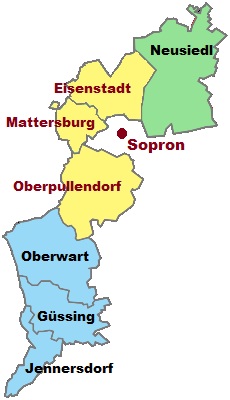 Prior to 1921, Sopron was the county seat of Sopron Megye, having within its county boundaries some 285,000 residents in the seven járás (districts) of Csepreg, Csorna, Felsopulya (now Oberpullendorf), Kapuvár, Kismarton (now Eisenstadt), Nagymarton (now Mattersburg) and Sopron. 49.7% of the county residents were of Hungarian extraction, 38.5% were Germans, 10.9% were Croatians, and the remaining 0.9% were Slovaks, Romanians, Serbians, Ruthenians and others. Religious affiliations were Roman Catholic (84.5%), Lutheran/Calvinist (12.3%/0.3%), Jewish (2.9%), and less than 0.05% of Greek Catholic, Greek Orthodox, Unitarian and other. The city, itself, boasted some 38,000 residents in 1920, being slightly German-dominated (51%), with Hungarians being the other large group (44%). It was also slightly more Lutheran/Calvinist (27.8%/1.2%) and Jewish (6.6%) than the surrounding county, causing the percentage of Catholics to be some 20 points lower, 64.1% (versus the county-wide 84.5%). Sopron was also the governing seat of the 1850s Military District of Ödenburg, one of the five administrative units of the Habsburg Kingdom of Hungary from 1850 to 1860. The district included parts of present-day Hungary, Burgenland, Croatia, and Slovenia that were then the southwestern section of Hungary. Historical Sopron From a historical perspective, Sopron was also one of the key towns in West Hungary, having been inhabited almost continuously since the sixth century BC. Its history is of interest to us Burgenländers as it is a history that we shared. The first permanent settlement in the current-day Sopron area was established by Celtic tribes and located on the Bécsi Hill at the bank of the Ikva creek, probably around the 9th-8th century BC. The first "castles," i.e., soil fortifications, appeared in the 6th-4th centuries BC (Iron Age). The plateau of Várhely was a fortified settlement of Illyrians in the Hallstatt-age. Around 350 BC, the area was reoccupied by the Celts and the building of fortifications and ditches continued until after the first appearance of the Romans. 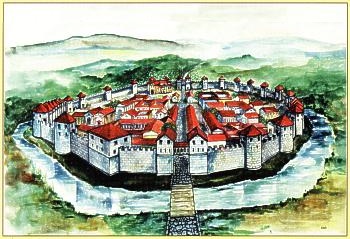 The
first real development of the settlement, however, was a result of the arrival of the
Romans during the reign of Tiberius (14-37 AD). First they established a presence on
the nearby hills but later (50 AD) moved into the area of today's city center, calling the new
town Scarbantia. As we've mentioned in past newsletters, the establishment of
Scarbantia was driven by its location at the junction of the Amber Road (going northeast to
Carnuntium) with two roads diverging northwest to Vindobona (Vienna). The Romans filled boggy
areas between the streams Ikva and Rák (which is mostly underground now within the city) and
constructed, using pilings, an elliptic fortress with entrances coinciding with today’s
Elokapu (Front Gate) and Hátsókapu (Back Gate) and with walls fortified by several bastions.
The main axis of the ellipse lay along the direction of the Amber Road and the pattern of
streets took up the form still visible today in the inner city. At first glance, building in
boggy areas seems to make little sense but, in an era where warfare was fought against
fortified towns by siege machines and tunneling, it was a strong defensive measure. The Roman
forum was where the main square lies today and included the Capitolium (i.e.,
City Hall) and the Basilica (the venue of judicial and commercial transactions), around which
citizens’ houses were built. An amphitheatre (on Bécsi Hill northwest of town), a cemetery on
St. Michael Hill (north of town) and the pottery workshops (today's Paprét, on the eastern
edge of town) also belonged to the town. The
first real development of the settlement, however, was a result of the arrival of the
Romans during the reign of Tiberius (14-37 AD). First they established a presence on
the nearby hills but later (50 AD) moved into the area of today's city center, calling the new
town Scarbantia. As we've mentioned in past newsletters, the establishment of
Scarbantia was driven by its location at the junction of the Amber Road (going northeast to
Carnuntium) with two roads diverging northwest to Vindobona (Vienna). The Romans filled boggy
areas between the streams Ikva and Rák (which is mostly underground now within the city) and
constructed, using pilings, an elliptic fortress with entrances coinciding with today’s
Elokapu (Front Gate) and Hátsókapu (Back Gate) and with walls fortified by several bastions.
The main axis of the ellipse lay along the direction of the Amber Road and the pattern of
streets took up the form still visible today in the inner city. At first glance, building in
boggy areas seems to make little sense but, in an era where warfare was fought against
fortified towns by siege machines and tunneling, it was a strong defensive measure. The Roman
forum was where the main square lies today and included the Capitolium (i.e.,
City Hall) and the Basilica (the venue of judicial and commercial transactions), around which
citizens’ houses were built. An amphitheatre (on Bécsi Hill northwest of town), a cemetery on
St. Michael Hill (north of town) and the pottery workshops (today's Paprét, on the eastern
edge of town) also belonged to the town.The Romans did not establish a military base, rather, they created a civilian trading town, inhabited by merchants and veterans, complete with art and culture. During the reign of Vespasianus, between 69-79 AD, the city became a municipium, a city with its own public administration and full civil rights for inhabitants. The ruins of 73 villa-farms have been found in the area and also remnants of wine-grape cultivation, handicrafts production and other commerce from this time. The settlement thrived in Roman times but suffered during the Pannonian tribal migration period. Successive invasions by German tribes, Huns, Eastern Goths, and Lombards all took their toll until the fortress city became nearly uninhabited and largely fell into ruin in 586 when the Avars drove out or destroyed the remaining Christians and Romanized inhabitants. However, the town does appear again in written records as Ödenburg in 856, when it was noted for the red wine produced there. Nonetheless, it would not begin to truly revive until after the Hungarian Conquest (about 900) when King Stephen built a border fortress on the ruins of Ödenburg's/Scarbantia's Roman walls, which were still 5-6m high. Construction of houses started within and at the foot of the castle walls and the line of the streets followed that of the walls: this resulted in an elliptic town centre with two squares, the Main Square (the former Forum) and the Salt Market (today’s St. Ursula Square). During this period, the settlement was referred to, in Hungarian, as Suprun, named after a castle steward named Suprun, or, in Latin, as Castellum Cyperon. 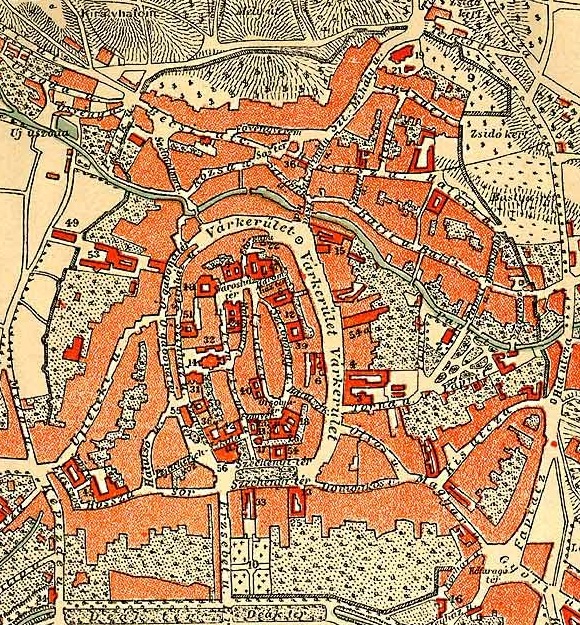 Year
1277 marked another turning point for the town, one still commemorated in the Fountain of
Faith memorial: King Otakar II of Bohemia had occupied the castle several times and, in
order to ensure the town’s fidelity, took as hostages the children of Sopron's nobility.
However, when the army of King László IV of Hungary arrived in 1277 to reclaim the city, it
opened its gates gladly, even though doing so cost the lives of their children. The king
rewarded Sopron for its fidelity and loyalty to the Crown by granting it the rank of free
royal town (one of only seven) and giving them border guard royal archers. A statue of Judge
István, the first known judge of Sopron, and also the first to express his loyalty to the
Hungarian crown, symbolizes the 1277 event in the Fountain of Faith. Year
1277 marked another turning point for the town, one still commemorated in the Fountain of
Faith memorial: King Otakar II of Bohemia had occupied the castle several times and, in
order to ensure the town’s fidelity, took as hostages the children of Sopron's nobility.
However, when the army of King László IV of Hungary arrived in 1277 to reclaim the city, it
opened its gates gladly, even though doing so cost the lives of their children. The king
rewarded Sopron for its fidelity and loyalty to the Crown by granting it the rank of free
royal town (one of only seven) and giving them border guard royal archers. A statue of Judge
István, the first known judge of Sopron, and also the first to express his loyalty to the
Hungarian crown, symbolizes the 1277 event in the Fountain of Faith.The construction of the outer city walls dates from that time. However, László IV prohibited settlement outside the walls and ordered that all who had already settled outside the city walls should move into the city—or risk loss of their estates. This decree marks the appearance of new, probably German, settlers in the area, and the establishment of the Újteleki (new lands) district outside the walls. Between 1277 and 1360, the former fortress became a flourishing free royal merchant town of some 2000 people, in which the German inhabitants gradually became a majority. After 1379, the area which lay outside the core but within the outer walls was divided into four quarters, the four suburbs of today, and by 1427 the number of inhabitants rose to 4000. The Reformation appeared in Sopron in 1524 and, in spite of the auto-da-fé (burnings of heretics), the majority of the citizens soon converted to Lutheranism. In 1526, the Jews were expelled from the city, supposedly because they were collaborating with the Turks. In 1529, the Turks ravaged the suburbs, but Sopron did not fall under Turkish rule. It became a haven for people from the occupied areas and the city's importance grew progressively; in 1553, 1622, 1625, 1635 and 1681, parliamentary sessions were held in the town. During these years, the defensive walls, gates and towers were refortified and a third system of stone walls was added around settlements in the quarters. 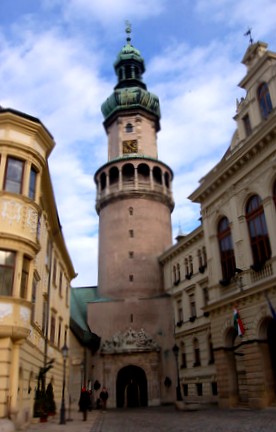 During
the late 17th century, a plague epidemic killed half of the population of Sopron and, in 1676,
a huge fire devastated the city, damaging many of the houses of the nobility. An
essentially new town was born in the next few decades, with Baroque buildings
replacing the medieval houses. It was in that period that Sopron became the seat of the
comitatus Sopron and the Firewatch Tower was completed. The Firewatch Tower (see right) is 60
meters (195 feet) tall, with 200 steps in a narrow circular staircase. Its square base was
built on a Roman gate in the 12th century, with the fire watch feature, the cylindrical middle
and arcaded balcony being from the 16th century and the baroque spire topping it in 1681.
After the Ottomans left the country, the castle trenches were filled and became vegetable
gardens and the castle moat was replaced by the Várkerület (Castle circle) roads. Despite the
population losses to plague and fire, the town grew to more than 11,000 inhabitants, all with
the right of citizenship, by the end of the 1700s. During
the late 17th century, a plague epidemic killed half of the population of Sopron and, in 1676,
a huge fire devastated the city, damaging many of the houses of the nobility. An
essentially new town was born in the next few decades, with Baroque buildings
replacing the medieval houses. It was in that period that Sopron became the seat of the
comitatus Sopron and the Firewatch Tower was completed. The Firewatch Tower (see right) is 60
meters (195 feet) tall, with 200 steps in a narrow circular staircase. Its square base was
built on a Roman gate in the 12th century, with the fire watch feature, the cylindrical middle
and arcaded balcony being from the 16th century and the baroque spire topping it in 1681.
After the Ottomans left the country, the castle trenches were filled and became vegetable
gardens and the castle moat was replaced by the Várkerület (Castle circle) roads. Despite the
population losses to plague and fire, the town grew to more than 11,000 inhabitants, all with
the right of citizenship, by the end of the 1700s. In the 1800s, the Jews were allowed to return and the town expanded beyond the four quarters (Viertels), into outer districts beyond the walls erected in the 17th century. These areas were called Front-town (Vorstadt), in order to distinguish them from the quarters inside the outer walls. Sopron did not participate significantly in the Hungarian Revolution of 1848 (which grew into a war for independence from the Austrian Empire ruled by the Habsburg monarchy). As a result, when the revolution was suppressed, the town became the centre of the Trans-danubian District, managing the financial, military and constabulary affairs of nine former counties. In 1850, a railway between Sopron and Nagykanizsa was established; however, the city missed out on the coveted railway line connecting Budapest and Vienna. After the establishment of the Austro-Hungarian Empire, Sopron re-gained her position as county capital. 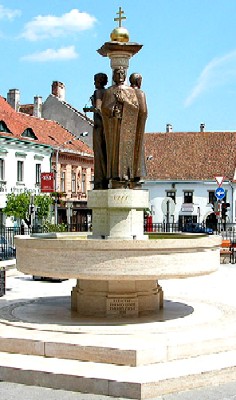 After
WW-I, a significant portion of Western Hungary was awarded to Austria by the Treaty of
Saint-Germain-en-Laye, territory which became Burgenland and was to include the Sopron járás.
However, as a result of a plebiscite held on 14 December 1921, Sopron and the area around it
remained Hungarian and the town was awarded the prestigious Latin title of "Civitas
Fidelissima" (the most allegiant town; Hungarian: A Leghuségesebb Város) by the
Hungarian government. Some historians argue that the town had already acquired this title in
the decree of László IV in 1277, thus the title of 1921 was only a renewal of the former one,
however, the medieval decree does not include the words "Civitas Fidelissima." Regardless, the
anniversary of the plebiscite is still a city holiday. This event is also commemorated in the
Fountain of Faith memorial (see right) via a statue of Mihály Sopronyi Thurner, who
held the office of Mayor between 1918 and 1941 and was influential during the preparations for
the referendum. As a sign of his respect and love for the city, he took up the middle name
'Sopronyi' at the beginning of the 1930s. After
WW-I, a significant portion of Western Hungary was awarded to Austria by the Treaty of
Saint-Germain-en-Laye, territory which became Burgenland and was to include the Sopron járás.
However, as a result of a plebiscite held on 14 December 1921, Sopron and the area around it
remained Hungarian and the town was awarded the prestigious Latin title of "Civitas
Fidelissima" (the most allegiant town; Hungarian: A Leghuségesebb Város) by the
Hungarian government. Some historians argue that the town had already acquired this title in
the decree of László IV in 1277, thus the title of 1921 was only a renewal of the former one,
however, the medieval decree does not include the words "Civitas Fidelissima." Regardless, the
anniversary of the plebiscite is still a city holiday. This event is also commemorated in the
Fountain of Faith memorial (see right) via a statue of Mihály Sopronyi Thurner, who
held the office of Mayor between 1918 and 1941 and was influential during the preparations for
the referendum. As a sign of his respect and love for the city, he took up the middle name
'Sopronyi' at the beginning of the 1930s. However, not all effects of the referendum vote were positive, for either Burgenland or Sopron. Burgenland lost its capital and a major transportation hub, plus part of Vienna's "kitchen garden." And Sopron became an isolated border town, which had serious social and economic consequences for many years. As noted above, the town lost its major market, Vienna, but tried to counter this by developing a textile industry and tourism. In the interwar period, there was increased ethnic tension and Germans in Sopron (and elsewhere in Hungary) came under heavy pressure to use the Hungarian language and to 'magyarise' their names. During WW-II, Sopron was invaded by German troops and suffered heavy bombardments (which luckily spared the central city). The Nazis and their Hungarian allies transported to death camps almost all of Sopron's Jewish citizens and some of its left-wing workers. Then it was invaded by Soviet troops in 1945 and so found itself on the wrong side of the Iron Curtain when the war ended. Sopron's German-speaking population was deported during the post-war years and, in 1950, the city lost the prestige of being a county seat. Worse yet, the town was located in the so-called "border-line," thus could only be visited with special permission during the Soviet era. Further, given its closeness to the Iron Curtain, even regular travelers in the area were frequently harassed on trains, public roads, etc. Over the years, the access difficulties led to a regression of industry and commerce and forced mines in the area to close. Luckily, the Baroque inner town was still well-preserved so, even before the Iron Curtain came down, Sopron initiated regular cultural events to show off her hidden beauties to visitors. 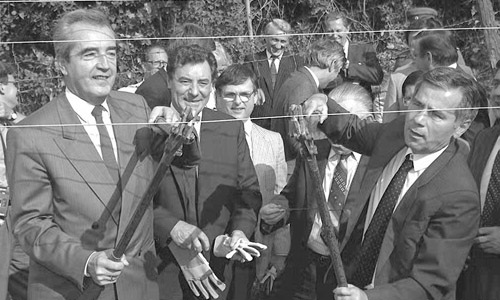 By
1989, Hungary was openly rebelling against the presence of the Iron Curtain and, on June 27
1989, Austria's foreign minister, Alois Mock, and his Hungarian counterpart, Gyula Horn,
together cut through the border fence near Sopron in a symbolic act to highlight Hungary's
decision to dismantle its installations along the border. Twenty-two days later, on August
19th, a Pan-European Picnic was held in nearby Fertörákos, where a border gate on the road
from Sankt Margarethen im Burgenland to Sopronkohida was to be opened for three hours.
Hundreds of East-Germans, who had been invited to the picnic, fled through the border to
Austria. In the months to come, over 70,000 people would flee to the West across Hungary's
border. By
1989, Hungary was openly rebelling against the presence of the Iron Curtain and, on June 27
1989, Austria's foreign minister, Alois Mock, and his Hungarian counterpart, Gyula Horn,
together cut through the border fence near Sopron in a symbolic act to highlight Hungary's
decision to dismantle its installations along the border. Twenty-two days later, on August
19th, a Pan-European Picnic was held in nearby Fertörákos, where a border gate on the road
from Sankt Margarethen im Burgenland to Sopronkohida was to be opened for three hours.
Hundreds of East-Germans, who had been invited to the picnic, fled through the border to
Austria. In the months to come, over 70,000 people would flee to the West across Hungary's
border. This event, the opening of the border (which quickly led to the fall of the Iron Curtain and the reunification of Germany), is the third event commemorated in Sopron's Fountain of Faith memorial, this one by a statue of a woman symbolizing liberty and holding a piece of the iron curtain in her hand. Sopron is rightfully proud of its faithfulness, both to country and to the spirit of freedom. 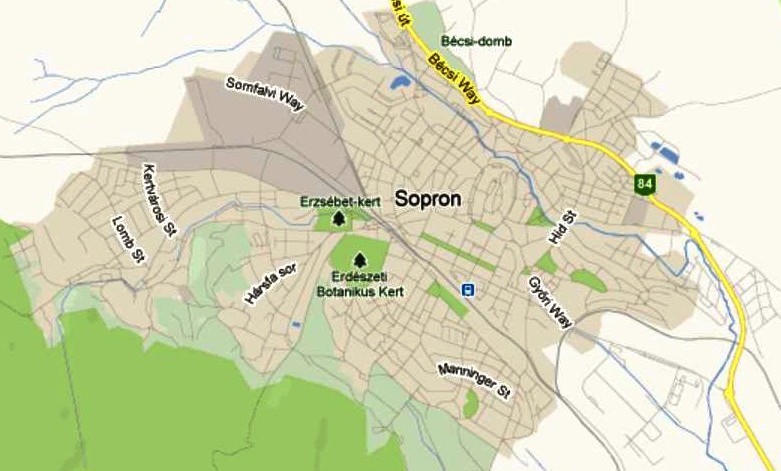 Sopron, now a town of nearly 61,000 residents, endeavors to become a venue of high quality tourism, entertainment, wine-growing and conferences, of which I will tell you more in the coming section. As you can see from the map above, it has expanded greatly to the southwest of the earlier core city. Sopron Today Sopron's economy has immensely benefited from the European Union. Having been a city close to nowhere for so long, Sopron has now re-established full trade relations with nearby Austria. Furthermore, after being suppressed during the Cold War, Sopron's German-speaking culture and heritage are now recognized again. As a consequence and due to its proximity to the Austrian frontier, many of the city's street-and traffic-signs are written in both Hungarian and German, making it an officially bilingual city. Visitors admire  the
large number of buildings that reflect medieval architecture—rare in historically war-torn
Hungary. Sopron receives many visitors from Vienna (70 km away), and from Bratislava, Slovakia
(77 km away), as well as from the United States, Great Britain, The Netherlands, Japan, and
Scandinavia. Many people visit to take advantage of the excellent low-cost dental services
offered: Sopron boasts so many dental clinics—more than 300—that the city is known as the
"dental capital of the world." the
large number of buildings that reflect medieval architecture—rare in historically war-torn
Hungary. Sopron receives many visitors from Vienna (70 km away), and from Bratislava, Slovakia
(77 km away), as well as from the United States, Great Britain, The Netherlands, Japan, and
Scandinavia. Many people visit to take advantage of the excellent low-cost dental services
offered: Sopron boasts so many dental clinics—more than 300—that the city is known as the
"dental capital of the world."As for the BB, we have 46 members who list Sopron (Ödenburg) as a village of interest and 33 more with interest in the other villages of the current Sopron járás: Ágfalva (Agendorf), Balf (Wolfs), Fertöbóz (Holling), Fertörákos (Kroisbach), Harka (Harkau), Kópháza (Kohlnhof), Nagyczenk (Großzinkensdorf), Sopronbánfalva (Wandorf). There are many tourist attractions. First among these is the Firewatch Tower near the main square (the Fo tér), which served both as its name implies but also to warn the city of approaching foreign soldiers. The tower guards also kept the time by sounding their trumpets from the balcony every quarter of an hour, then, from the 16th century, they managed the tower clock. They also showed their musical talent by providing music at weddings, funerals, and town festivals. The tower is also a symbol of faithfulness with a Baroque door-frame and a sculptural group entitled "The people of Sopron paying homage to the mythological figure of Hungaria" around and above the "Gate of Faith" in the base of the tower. 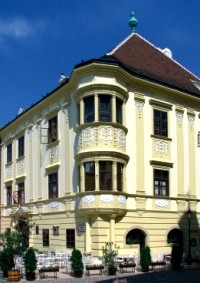 The Storno House and its exhibition on the first floor on the history of Sopron County is another attraction on the main square. It is a castle-like Baroque corner house that was once the property of the Haberleiter family and provided accommodation for King Matthias in 1482–83. The building hosted two concerts by Franz Liszt, in 1840 and 1881, and was home for Sopron’s first apothecary, the Black Elephant (Fekete Elefánt), in the 15th century. The rooms, decorated with antique furniture as well as the works of family members, give a true picture of interior design at the end of the 19th century. The collection comprises valuable items of furniture, weaponry, china and glass art, which can be seen on the second floor, where the Storno family lived from 1875 to 1984. The Fabricius House features a Roman bath in the basement, a Gothic hall, a loggia in the courtyard and Gothic and Baroque cellars. The house is named after Endre Fabricius, who was mayor and magistrate and purchased the house in 1806. The building hosts three exhibitions. The cellar contains remains from Roman Scarbantia: headstones, altar stones, statues, sepulchral urns of stone, and sarcophagi. Two floors at the back of the building host an archeological exhibition, "Three-thousand Years on the Amber Road." The rooms on the first and second floors show the changes in interior design between the 17th and 18th centuries, by presenting objects and furniture of those times. 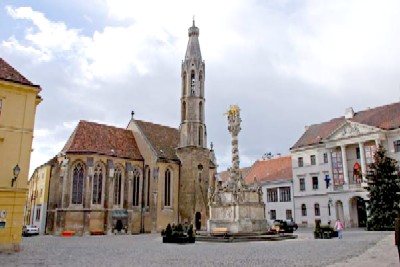 The Goat Church (A Kecske-templom) was originally a Franciscan monastery in the centre of town. Around 1280, they built a church, popularly known as "the goat church", which is an outstanding example of Hungarian Gothic architecture. During the centuries the church was the site of coronations and numerous parliamentary sessions. Its tower and masterpieces by fresco painters and other artists, the lancet windows, and the Capistran pulpit are highly admired. The most important building on the Forum of Scarbantia, the Capitolium, was discovered in the winter of 1893, during the construction of the City Hall. The exact size and position of the Forum was determined by excavations in the 1960s when the pedestals of three bronze equestrian statues were found on the southern part of the square. and altars to different gods were discovered on the sides of the Forum. 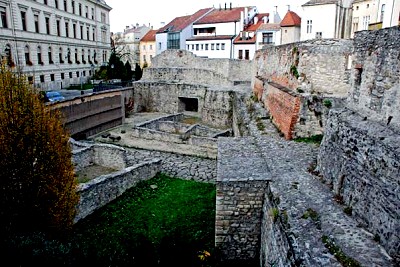 The
temples of the three main gods – Jupiter, Juno and Minerva - were situated at the highest
point of the town. The exhibition of the monumental architectural work recalls life in the
former Roman town. The
temples of the three main gods – Jupiter, Juno and Minerva - were situated at the highest
point of the town. The exhibition of the monumental architectural work recalls life in the
former Roman town.The National Lutheran Museum provides the history of the Lutheran congregation in Sopron dating back to the time of the Reformation in Hungary. The Lutheran church of Sopron is the oldest, most outstanding architectural work of the period after the issue of the Edict of Tolerance. There are frequent organ concerts here, as the huge instrument has an unforgettable tone. The treasury of the church has a rich collection of Hungarian and foreign masterpiece ecclesiastical objects: communion goblets, jugs, ciboria, candlesticks and altar cloths. The Archives holds documents from the middle of the 16th century onwards and the library hosts over 6000 books, handwritten Bibles and basic theological works that are available for interested researchers. 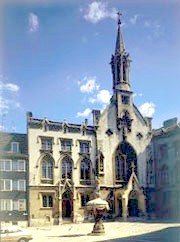 The neo-Gothic Ursuline Catholic Church (Orsolya-templom) is an impressive architectural monument of the past century. Its Catholic Convent, in the oratory of the former Ursuline monastery, hosts the Collection of Roman Catholic Church Art. The convent collected, and thereby saved, damaged objects of church art, renewed them, and made them available for art historians, researchers and the public. The material includes Baroque art and sacral objects, plus earlier and 19th century relics. The goblets, reliquaries, crucifixes, ceremonial and baptizing pitchers and crosiers, the sculptures and the intact parts of the altars, and the Baroque vestments and robes bear evidence of the richness of previous centuries. There are many additional places of interest in Sopron beyond these but, rather than describing them, I will only list them below. • Széchenyi Square and Flag of Loyalty • Eggenberg House (early Lutheran worship place with interesting architecture / grounds) • City Hall (eclectic, 1895) 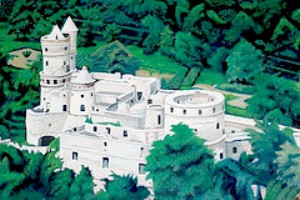 • Taródi Castle (fairytale "medieval" castle built starting 1950) • Two Moors House (baroque, made from two 17th-century peasant houses) • Chemist's Museum (declared a national monument by Louis II in 1525) • Gambrinus House (old city hall) • Other remains from the town's earlier Jewish community • The Holy Trinity Statue (a masterpiece of the Hungarian baroque) • Central Museum of Mining • Forestry Collection • József Soproni Horváth collection ("the great painter of Sopron") • Zettl–Langer collection (ceramics, paintings and furniture) • Bakery Museum • The Lábasház (an arcaded house in Orsolya Square) Simply walking the streets of the inner town will reveal many medieval houses, with gables and spacious courtyards, along interesting, narrow streets filled with architectural rarities built in Gothic, Baroque and Renaissance styles, complete with historical monuments and local culture. There is the medieval atmosphere of the squares, the delicately fashioned balconies, and the arched gateways with their Gothic sedilia (stone seats, recessed into walls) and the cheerful, inviting wine cellars. From many areas one can catch a glimpse of the old town walls. The Esterházy, Erdödy, Széchenyi and Zichy-Meskó mansions witness that the Sopron area was a highly popular place of residence also among the families of Hungarian aristocracy. Then there are the collections of local history, scientific and industrial history, and art and religious items that are displayed in a total of 23 permanent exhibitions in Sopron. Further out, into the surrounding Sopron járás, there is Brennbergbánya, the first coal mine of Hungary, which supplied charcoal to the industry of the region from 1752 to 1952 (and was one of the factors motivating Hungary to retain Sopron in 1921). The Lövérek, a forested, hilly area on the southwest edge of town, with the Károly-kilátó (Charles Lookout Tower), that offers a pleasant walk or a popular place for serious hiking. The baroque Esterházy Palace in Fertod, the village museum of traditional houses in Fertoszéplak, the museum of the 'greatest Hungarian', István Széchenyi, in Nagyczenk, the Cave Theatre and the stone quarry (which supplied paving and building stone for the Romans) in Fertörákos, and the Maria Magdalena church at Bánfalva are other places of special interest. Sopron is also known for its annual festivals. Among the many are the following: • Spring Festival of Sopron (Soproni Tavaszi Fesztivál) held from late March into April, features music, cultural and theatre events presented by famous native and foreign artists. 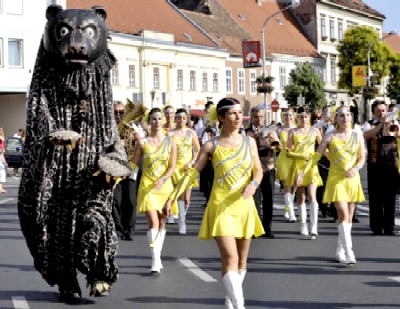 •
Festal Weeks of Sopron (Soproni Ünnepi Hetek) held from late June into July,
features parades, theatre, music, talent shows, costume (fairies and elves)
competitions and fireworks. •
Festal Weeks of Sopron (Soproni Ünnepi Hetek) held from late June into July,
features parades, theatre, music, talent shows, costume (fairies and elves)
competitions and fireworks.• VOLT festival (the festival of electronic music) held early July in the Lövérek, is a four-day multicultural festival with 15 stages and approximately 200 programs: concerts, DJs, theater shows and performances of a wide variety of musical styles: rock, pop, jazz, hip-hop, electro, world music, etc. Had nearly 100,000 attendees last year. • Civitas Cellar Theater (Civitas Pinceszínház), features repertory theater, mime, drama, comedy, cabaret, absurd and children's pieces plus 150+ lectures each year in a medieval basement setting. • Early Music Days Festival in June is a forum for Hungarian and foreign historical music, performers and ensembles; held at the Franz Liszt Conference and Cultural Centre (Liszt Ferenc Muvelodési Központ), a comprehensive conference center that also utilizes its auditorium spaces for concerts. • Sopron Wine Festival is mainly about the wine, with opportunities to taste wines and discuss viniculture, but also provides musical entertainment and good foods to pass the evenings. • Pan-European Picnic, an annual commemoration on August 19th of the Pan-European Picnic, the meeting of European nations that takes place in Sopronpuszta, at the scene of the border opening in 1989. The event popularizes the idea of a common Europe without frontiers. Wine Production Sopron is a significant wine producing region, one of the few in Hungary to make both red and white wines. Grapes include Kékfrankos for red wine and Traminer (Gewürztraminer) for white wine. Not surprisingly, its climate is similar to the  Burgenland
wine region so several winemakers make wine in both countries. Blue Frankish, Traminir, Pinot
Noir and Green Veltelini are well-known Sopron wines. Visitors should not miss trying
Kékfrankos, the most famous of the Sopron wines. Mentioned above, the Sopron Wine Festival is
renowned through out Europe and is attended by both wine experts and interested public. Burgenland
wine region so several winemakers make wine in both countries. Blue Frankish, Traminir, Pinot
Noir and Green Veltelini are well-known Sopron wines. Visitors should not miss trying
Kékfrankos, the most famous of the Sopron wines. Mentioned above, the Sopron Wine Festival is
renowned through out Europe and is attended by both wine experts and interested public.The region is one of the oldest wine-growing regions of historical Hungary, with traditions based on a wine culture created by the Celts and the ancient Romans. In the 14th century, it was considered one of the most important wine-growing regions of the country, having trade connections that spanned national borders. Unlike in other regions, the wine cellars are traditionally below the winemakers house inside the city, rather than at their hillside wineries. This provided more safety and protection for the winemakers. The most valuable wine-growing areas are the hillsides near Lake Fertö (Neusiedlersee), with climatic conditions and the salinity of the soil and water contributing to the uniqueness of the region's wines. In the time of the Monarchy, the grape-growing areas around the lake formed a single wine-growing region under the name Sopron-Ruszt-Pozsony and grew similar types using similar methods. The epidemics destroying the grape plantations and the "storms of history" gave individual direction to parts of the region. White grapes dominated the area around Sopron until the end of the 1800s. The characteristic type of the region now, the Blue Frankish grape, came to the fore after the 1890s. It is a peculiarity of the region that the climate here is advantageous for the production of late-harvested sweet wines as well. These wine types are not new in this area; their presence goes back to the 16th century. Jewish Sopron Sopron no longer has an active Jewish community, however, there are relics of their various times in Sopron. Hannes Graf, on his Spirit of Gradišće - Őrvidék Group website has three articles about Jewish Synagogues in Sopron. Rather than reprint them here, I'll provide links to each article: Old Synagogue, Uj utca 11 (a medieval synagogue built about 1370) Old Synagogue, Uj utca 22 (an early gothic synagogue built about 1300) Old Synagogue, Papret (an orthodox synagogue built in the early 1890s) All are no longer actively used as synagogues. |
||||||||||||||||||||||||||||||||||
5) HUNGARIAN TRANSLATIONS BB member Joe Jarfas of Equinunk, PA, has occasionally commented on articles in the BB Newsletters, most often to correct or improve my feeble efforts at reading or translating the subtleties of the Hungarian language. This past month, he volunteered a slightly improved reading and translation of the text I shared in Article 2 of last month's newsletter, that being the comment section from a birth record of interest to Nina Egert. Later in the month, I directly sent some Hungarian text to Joe, mainly because I needed help with the subtleties (prefixes and suffixes on words I knew) and interpretation of abbreviations and ecclesiastic terms (or worse yet, abbreviations of ecclesiastic terms!). This last was typed text, so the reading of it was no challenge. The Birth Record This was text from article "Pulling the Thread" in the Newsletter 225, last month... I read the text as: Az atya Makuniov községben, Moscis-ka kerületi, Galiczia, ben illetoséggel. Joe provided: Az atya Makumiov községben, mocsis-kai kerület, Galiczia, bír illetőséggel. My translation was: The father Makunióv village, Mosciska district, Galicia, was a resident.” Joe's crucial change was from “ben” to “bír”, which strengthens, in important ways, the father's tie to village Makunióv… he not only “was a resident”, rather he "is a resident" or “belongs as a resident.” As Joe said, "The translation pretty much remains the same. The word 'bír' is a
possessive verb here, expressing he belongs there." Joe also went on to say, "We all
know the place names were written phonetically..." which is why he did not belabor the
exact spellings of the village or district. |
||||||||||||||||||||||||||||||||||
6) HISTORICAL BB NEWSLETTER ARTICLES Editor: This is part of our series designed to recycle interesting articles from the BB Newsletters of 10 years ago. The articles that I've chosen to reprint continue the submissions of BB member Gerhard H. Lang, as provided as a series in Newsletters 109 to 112 (July to November, 2002). The pieces I've chosen this time are from newsletters 111 & 112 and were actually written by Matthias Artner of Großhöflein. THE BURGENLAND BUNCH NEWS No. 111 & 112 October 31 & November 30, 2002 AT THAT TIME - GROßHÖFLEIN 100 YEARS AGO (by Matthias Artner) 80 years Burgenland (From Newsletter 111) Eighty years ago in 1921, that territory of "Deutschwestungarn", which was adjudicated in the treaty of Saint-Germain on Sept. 10, 1919 by the victorious forces, came to Austria. It was not known as "Burgenland" because that name didn't exist before. This was a piece in Western Hungary. At the beginning, some strove for complete independence, and wanted to name this place "Deutschwestungarn." On Dec. 6, 1918, the republic of "Heinzenland" had been proclaimed in the Mattersburg district. On Dec. 15, some communities in the southern "Deutschwestungarn" also demanded affiliation to Styria. Many civil service people and clergy -- fluctuating between loyalty for the state and the public -- only saw an answer by achieving self-government within Hungary. As is generally known, the name of Burgenland has its origin in the four Western-Hungarian counties, with names ending in "-burg". Therefore our land should be named "Vierburgenland", but then they removed the numeral and left it as "Burgenland". The new province had no regional capital due to the plebiscite at Sopron (the Austrian National Council determined on Jan. 25, 1921, that the regional capital of Burgenland should be the town of Sopron, which then decided to remain in Hungary). As a result here were neither administrative institutions nor an administrative machinery. Many Hungarian teachers either moved to Hungary or retired. Classes often had up to 100 pupils and there was a great demand for teachers. The government then sent for many "German" administrative officers and teachers, causing resentment among the "original" Burgenländer teachers. On May 18, 1922, Cardinal Friedrich Piffl was appointed Apostolic Administrator. The region had about 245,000 Catholics at this time. Little by little, the annexation to Austria was organized. Administration became more and more democratic. "Richter" (judge) became "Buergermeister" (mayor); they lost their judicial function. The "Notaer" (notary), originally superior, was placed below the mayor and became the village secretary (Amtmann - chief or office manager). Johann Frank, born at Neckenmarkt in 1882, was appointed as the headmaster of the R.C. School in 1923. Associated with his "Kantorlehrerstelle" (cantor-teacher-employment) were the following benefits: From the municipality: 560 crowns (10,000 were equal to one Schilling in 1924), also the monetary value of 690 kilograms grain, 1020 liters wine, 4 klafters of logs and 400 bunches (Buertel), 8 Joch croft and an adequate apartment. The 1st Austrian Republic (From Newsletter 112) After WW I peace returned, but hunger and the fight for daily existence took the place of war. Everywhere there was a shortage of raw material and foodstuffs. No one wanted to deliver goods to Austria. Currency was devalued- in 1913 for 20.000 crowns one could buy a house, but in 1920 it bought one pig and in 1922 just 3 kilograms of bread. Prelate Dr. Ignaz Seipel accepted the office of Federal Chancellor in 1922. To reduce inflation he restored confidence in foreign countries and got a loan of 650 million gold crowns from the League of Nations. Thereon the new "Schilling" currency was introduced, 10,000 crowns being equal to one Schilling. The year 1927 was a time of insurrection. Many well-armed militant groups arose, like the "Heimwehr" and "Republikanischer Schutzbund" which held meetings and maneuvers, during which disturbances often took place. These reached their climax in the "shootings of Schattendorf" where two people died. Some radical demonstrators also set fire to the Viennese palace of justice. The authoritarian policies of Federal Chancellor Dollfuß in 1932 and the critical political situation were characteristic for those times. There were many hundreds of thousands of jobless people and many of them were "ausgesteuert," meaning they received no subsidy at all. People became desperate and turned to political parties that promised remedies. Social Democrats and National Socialists stood in sharp contrast to the authoritarian state Patriotism-Front that appeared in 1934. As the police searched the headquarters of the Social-Democratic party in Linz for forbidden weapons, there was open rebellion. Over 300 people died. Although Dr. Dollfuß proclaimed a new Austrian Constitution on May 1, 1934 - starting with the words "In the name of God, from whom all the justice comes" - peace was still not established. A National-Socialistic wave of terror started, which led to a putsch during which Dr. Dollfuß was murdered in the Chancellor's office. The judges and mayors who led Großhöflein village in those hard days were Johann Steiner - 1927, Matthias Erdt - 1928 - 1931, Josef Zechmeister - 1932 - 1934, Philipp Tomschitz - 1935 - 1938. |
||||||||||||||||||||||||||||||||||
7) ETHNIC EVENTS LEHIGH VALLEY, PA (courtesy of Bob Strauch) Saturday, December 1 - Sunday, December 23: Christkindlmarkt in Bethlehem. Info: www.artsquest.org/christkindlmarkt Saturday, December 1 - Sunday, December 23: Weihnachtsmarkt / Open-Air Christmas Market in Bethlehem. Info: www.christmascityvillage.com Saturday, December 1: Weihnachtskonzert / Christmas Concert by the Lehigh Sängerbund Chorus at Egner Memorial Chapel, Muhlenberg College, Allentown. Info: www.lehighsaengerbund.org Sunday December 2: Christkindlmarkt at the Reading Liederkranz. Info: www.readingliederkranz.com December 4: German-English Advent Singstunde in the Old Moravian Chapel in Bethlehem. Info: www.moravianchurcharchives.org December 8: Christmas Concert with the Lancaster Liederkranz Chorus at Zion Evangelical Lutheran Church in Landisville. Info: www.lancasterliederkranz.com December 8: Christmas Dinner and Dance at the Lancaster Liederkranz. Music by the Hank Haller Orchestra. Info: www.lancasterliederkranz.com December 8: Christmas Concert and Dance at the Coplay Sängerbund. Music by the Coplay Sängerbund Chorus and the Joe Weber Orchestra. December 12: Christmas Dinner Show at the Evergreen Heimatbund in Fleetwood. Info: www.evergreenclub.org December 15: Christkindl Auction at the Evergreen Heimatbund in Fleetwood. Info: www.evergreenclub.org December 16: German Christmas Service with the Reading Liederkranz Singers at St. John’s Lutheran Church in Reading. Info: www.readingliederkranz.com December 31: New Year’s Eve at the Coplay Sängerbund. Music by the Johnny Dee Orchestra. December 31: Silvesterball at the Reading Liederkranz. Info: www.readingliederkranz.com December 31: New Year’s Eve at the Lancaster Liederkranz. Music by the Joe Weber Orchestra. Info: www.lancasterliederkranz.com December 31: New Year’s Eve at the Evergreen Heimatbund in Fleetwood. Music by the Joe Kroboth Orchestra. Info: www.evergreenclub.org LANCASTER, PA Saturday, December 8, 5-6 pm: Fall & Christmas Concert featuring the Lancaster Liederkranz Chorus (free). Zion Evangelical Lutheran Church, 85 E Brandt Blvd, Landisville. Saturday, December 8, 7:30-11:30 pm: CHRISTMAS DINNER & DANCE. Lancaster Liederkranz. (Buffet: $12, $6 Child; Dance: $8 / $10 guests). Music by Hank Haller. NEW BRITAIN, CT Friday, December 7, 7 pm: Heimat Abend. Austrian Donau Club, 545 Arch Street, New Britain, CT (860 223-9401). Music by Joe Rogers. Friday, December 21, 7 pm: Heurigan Abend. Austrian Donau Club. Music by Schachtelgebirger Musikanten. |
||||||||||||||||||||||||||||||||||
8) BURGENLAND EMIGRANT OBITUARIES (courtesy of Bob Strauch) Helen Racz  Helen
Racz, age 87, of Highland, New York, died Tuesday, October 30, 2012 at home, after a long
illness. Helen
Racz, age 87, of Highland, New York, died Tuesday, October 30, 2012 at home, after a long
illness.Born on November 21, 1924, in Clifton, NJ, and raised in Tobaj, Austria, she was the daughter of the late Joseph and Valeria (Raubold) Racz. She worked at Gotlebs Sewing Company for 26 years as a designer of fine clothing, from 1924 till 1961. She then perused a career as a quality control inspector at IBM, where she retired in 1987. She spent many hours gardening and landscaping her rock gardens. When she wasn't bowling, she loved going to Atlantic City with group trips, and especially enjoyed her trip to Europe. Miss Racz was also a communicant at St. Joseph's Church for 60 years. She is survived by her brother Adolph and his wife Hildegard Razz of Highland, NY; niece, Marie Menzor of Highland, NY to whom she was a second mother; also by many nieces and nephews. She was predeceased by her sister, Pauline Zettl, and brother, Joseph Racz. Calling hours will be held on Sunday, November 4, 2012 from 1pm to 3pm at Copeland Funeral Home, Inc., 162 South Putt Corners Rd., New Paltz, NY 12561. The funeral will be held on Monday, November 5, 2012 at 10:00am at St. Joseph's Church, 34 South Chestnut Street, New Paltz, NY., where a Mass of Christian Burial will be celebrated by Fr. Bernard Maloney. Burial will follow in Lloyd Cemetery, Highland, NY. The family asks that memorial donation may be made to: Alzheimer's Association , 2 Jefferson Plaza, #103, Poughkeepsie, NY 12603. Funeral arrangements are by Copeland Funeral Home, Inc., 162 South Putt Corners Road, New Paltz, N.Y. 12561. (845)255-1212. If anyone wishes to express condolences online please go to www.copelandfhnp.com. Published in the Poughkeepsie Journal on November 1, 2012 Maria Hollendonner  Maria
Hollendonner, 93, of New Hope, Pennsylvania, formerly of Trenton, New Jersey died peacefully
with her daughter by her side on Wednesday, Nov. 7, 2012, at the Pine Run Health Center in
Doylestown, PA. Maria
Hollendonner, 93, of New Hope, Pennsylvania, formerly of Trenton, New Jersey died peacefully
with her daughter by her side on Wednesday, Nov. 7, 2012, at the Pine Run Health Center in
Doylestown, PA.She was the wife of the late Robert Hollendonner. Born in Northampton, PA, and raised in Deutsch Ehrensdorf, Austria, she was a daughter of the late Robert and Maria Pflugler. She was an active member of St. Anthony's Church in Trenton. In 2000, Mary joined her daughter, Lorraine, in her home in New Hope. She was known for her warm hospitality and always made sure that her guests were well cared for by serving them her Austrian specialties. She was self-taught and her handiwork included exquisite, delicate porcelain figurines, especially religious pieces. Her relatives and friends cherish the many treasures Mary made and gifted to them. She is survived by her daughter, Lorraine M. Doan of New Hope; her son, Robert R. Hollendonner of Washington, DC; her grandchildren, Bob Doan and his wife, Jessica, of New Hope and Karen M. Doan of Midland Park, NJ; her great-grandchildren, Logan and Ella Doan of New Hope, and her sister, Johanna Csencsits of Deutsch Ehrensdorf, Austria. The Funeral Mass will be offered on Monday, Nov. 12, at 11 a.m. at St. Martin of Tours Church, 1 Riverstone Circle, New Hope, PA. Interment will follow at the Trinity Episcopal Church Cemetery in Solebury, PA. Calling hours will be held at the church on Monday morning from 10 a.m. until the start of Mass. The rosary will be prayed at 10:30 a.m. Donations may be made to St. Martin of Tours Church, Aid for Friends Fund, 1 Riverstone Circle, New Hope, PA 18938. Arrangements are by the Van Horn-McDonough Funeral Home, 21 York St., Lambertville, NJ 08530. Published in The Times, Trenton, on November 10, 2012 Theresa Engelhard  Theresa
Engelhard, 98, a resident of Holmes, New York, passed away Friday, November 09, 2012 at the
Putnam Nursing & Rehab Center, Holmes, NY. Theresa
Engelhard, 98, a resident of Holmes, New York, passed away Friday, November 09, 2012 at the
Putnam Nursing & Rehab Center, Holmes, NY.Born in Moschendorf, Austria on October 6, 1914, she was the daughter of Paul and Agnes (Wiener) Gaspar, and wife of the late Ludwig Engelhard. Theresa and her family moved from Queens, and settled in Holmes in 1954. Theresa loved gardening, cooking, and reading. She is survived by her son Richard, and his wife, Linda, of Holmes; her granddaughter Theresa Engelhard of Tuckahoe, NY; and her sister, Albine Garr of Austria. In addition to her husband and parents, she is predeceased by her son, Ludwig. Friends may call at the Horn & Thomes, Inc. Funeral Home, 83 East Main Street, Pawling, NY on Monday, November 12th from 10-10:30 AM. A Mass of Christian Burial will follow at 11 AM at St. John's Church, 39 East Main Street, Pawling, NY. Burial will be in St. John's Cemetery, Pawling, NY. Published in the Poughkeepsie Journal on November 10, 2012 Frank Forjan  Frank
Forjan, 87, of Circleville, New York, died Nov. 6, 2012, at Orange Regional Medical Center in
Middletown. Frank
Forjan, 87, of Circleville, New York, died Nov. 6, 2012, at Orange Regional Medical Center in
Middletown.He was born Sept. 9, 1925, in Philadelphia, Pennsylvania, to parents Josef and Mathilde (Windisch) Forjan but grew up in Grieselstein, Austria. He moved back to the United States and had a long career as a precision machinist. Survivors include his wife of 65 years, Maria; two sons, Joseph Forjan and his wife, Marie, and Gary Forjan and his wife, Liz; two daughters, Christine Fediuk and her husband, Roman, and Laurie Sokoloff and her husband, Don; six grandchildren, Joseph Perry, Derek Sokoloff and Matthew, Daniel, Connor and Keara Forjan; a sister, Frida and her husband, Fred Steir; and many nieces and nephews. Frank was preceded in death by his parents; three brothers, Joseph Forjan and his wife, Louise, and William and Felix Forjan; a brother-in-law, Edward Henderson; a nephew, William Forjan; and a niece, Martha Forjan. A funeral Mass was celebrated Nov. 10 at St. Paul's Roman Catholic Church in Bullville, with the Rev. Sean Harlow, O.Carm, officiating. Burial followed at New Prospect Cemetery. In lieu of flowers, memorial contributions may be made to St. Paul's Roman Catholic Church. William M. Gagan Funeral Home Inc., 1525 Burlingham Rd., in Pine Bush, handled his funeral arrangements. To leave a message of condolence, visit www.wmgaganfuneralhome.com. Published in Newsday Westchester on November 12, 2012 Rose Schanter  Rose
Schanter (née Deutsch), age 82, of Gardiner, New York, passed away on Saturday, November 10,
2012 at her home, surrounded by her family and dogs. Rose
Schanter (née Deutsch), age 82, of Gardiner, New York, passed away on Saturday, November 10,
2012 at her home, surrounded by her family and dogs.She was born on July 3, 1930, in Pennsylvania and raised in Glasing, Austria. She was an owner along with her late brother, Steve, and her late husband, Hans, of the Castle Harbour Casino, Bronx, NY. Surviving are one daughter, Rosemarie Schanter and fiancé Dr. Saharat Bhitiyakul of Wallkill, NY and one son, John Schanter, and two grandchildren, Meghan and Jonathan Schanter. The funeral service will begin at 11:00 am on Tuesday, November 13, 2012 at Charles Borromeo Church, Route 44/55, Gardiner, NY 12525 (845) 255-1374, where a Mass of Christian Burial will be Celebrated by Rev. Robert Panek, Pastor. Burial will follow at St. Charles Cemetery. Memorial donations may be made to: Ulster County SPCA, 20 Wiedy Road, Kingston, NY 12401 or Benedictine Health Foundation c/o The Rosemary Gruner Fund,105 Marys Avenue, Kingston, N.Y. 12401 or Catskill Animal Sanctuary, 316 Old Stage Road, Saugerties, NY 12477. Funeral arrangements are by Copeland Funeral Home, Inc., 162 South Putt Corners Road, New Paltz, N.Y. 12561. (845)255-1212. If anyone wishes to express condolences online please go to www.copelandfhnp.com. Rudolph M. Schuster  Rudolph
M. "Rudy" Schuster, 84, of Limeport, Pennsylvania, passed away on Tuesday, November 20, 2012
in his home. Rudolph
M. "Rudy" Schuster, 84, of Limeport, Pennsylvania, passed away on Tuesday, November 20, 2012
in his home.He was the husband of Trudy (Griebel) Schuster and they celebrated their 59th anniversary this past June. Born in Allentown, but raised in Rábafüzes (Raabfidisch), Hungary, Rudy was a son of the late Michael and Julianna (Heber) Schuster. Rudy was a member of St. Joseph's Catholic Church in Limeport. Rudy worked for ConEd at Indian Point as a senior quality radiograph assurance examiner, specializing in radiography. He proudly served his country in the U.S. Army during the Korean War and was a member of the VFW in Emmaus, PA. He was the founder and past president of the Allentown Soccer Club, which was established in 1952. He was a volunteer fireman for the Continental Village Fire Dept. in Peekskill, NY for many years. He was the entertainment chairman for many years for the German American Social Club in Peekskill, NY. Rudy was a past Grand Knight of the Knights of Columbus in Allentown, and was a Fourth Degree Member of Calvary Council #528. He was a past president of the Lehigh Sängerbund, and he was a member of the Coplay Sängerbund. Rudy loved to travel and work in his garden. He was especially proud of and enjoyed his new crop of grandchildren. Survivors: Surviving with his wife, Trudy are sons, Michael and his wife, Mary of East Windsor, CT, David and his wife, Jen of Belmont, MA, and Rudy Jr. and his wife, Kirsten of Ft. Collins, CO; daughters, Susan Williams of Windham, CT and Donna, wife of Lane T. Bradford of Bolton, CT; a sister, Agnes, wife of John Bodisch in Center Valley. Additionally, Rudy is survived by his 11 grandchildren and three great-grandchildren. He was predeceased by his daughter, Monica; his grandson, Jason Bates; and his siblings, Julia, Mary, Hilda, and Otto. Services: A Mass of Christian Burial will be celebrated on Monday, November 26, 2012 at 10 a.m. in St. Joseph's Catholic Church. Calling will be on Sunday from 3 to 5 p.m. in the O'Donnell Funeral Home, 908 Hanover Ave., Allentown, and on Monday from 8:45 to 9:45 a.m. in the church. Contributions: In lieu of flowers, contributions may be made to ALS Philadelphia Chapter c/o the funeral home. Published in Morning Call on November 22, 2012 Wilhelm Fiedler  Wilhelm
A. "Willi" Fiedler, age 86, of Toledo, Ohio, passed away on Wednesday, November 21, 2012,
where he was surrounded by his loving family. Wilhelm
A. "Willi" Fiedler, age 86, of Toledo, Ohio, passed away on Wednesday, November 21, 2012,
where he was surrounded by his loving family.He was born on January 22, 1926, to Michael and Luise (Pfandler) Fiedler in Sopron (Ödenburg), Hungary. Willi immigrated to the United States in 1952 and settled in Toledo in 1954, where he and his wife, Ursula, raised their family. He was a Mason Contractor and owned his own business for 45 years in Toledo, (F & L Mason Contractors). Willi was a member of the Home Builders Assoc., GAF Retirees, GBU Schuetzenverien at the Oakshade and the Local 1 Bricklayers Union (50 year member). A large portion of his life and his family's life was devoted to the GBU (Greater Beneficial Union). Since settling in Toledo in 1954, Willi and his family were members of the GBU, where he was the President of Disctrict #510 - Toledo for 35 years. Willi was instrumental to the GAF [ED: German American Festival] Society, he was one of the Founding Fathers and truly enjoyed the time he dedicated to the GAF Society. He also served as a past chairman of the annual GAF festival. He also was influential with obtaining the Oak Shade Grove property and managed many of the volunteers who built the hall and clubhouse for the GAF Society. He worked relentless hours in hopes to strengthen the GBU District #510, the GAF Society and the GAF grounds. In his spare time, he enjoyed cheering for the Northwestern University football team, traveling with his wife by cruise ship, playing cards and shooting air rifles. Left to cherish his memory is his loving wife of 65 years, Ursula M. (Muschik) Fiedler; children, Gisela (Steven) Mohr, Irmgard (Richard) Green, Christine (Terry) Blackman and Michael (Vickie) Fiedler; grandchildren, Nicole (Dave), Natalie (Derek), Krista (Billy), Julie (Shaun), Kyle, Brooke, Shelly (Richard), Erin (Matt), Michael and Sydney; ten great-grandchildren, and brother, Ferdinand (Elfriede) Fiedler. In addition to his parents he was preceded in death by three of his brothers. The family will receive guests on Saturday, December 1, 2012, from 10:00 a.m. - 1:00 p.m. at Newcomer Funeral Home, 4150 W. Laskey Rd. (419-473-0300). Funeral Services will begin in the funeral home on Saturday at 1:00 p.m. Interment will follow in Ottawa Hills Memorial Park. Memorial contributions may be made to Hospice of Northwest Ohio. The family would like to specially thank the nurses and staff at Hospice of Northwest Ohio for the diligent care and compassion they provided to Willi. Published in Toledo Blade from November 25 to November 28, 2012 Alternative Obit: Wilhelm Alfred Fiedler (1926-2012) A Hungarian native of German heritage who helped found Toledo's German-American Festival and as a mason built homes in town, Wilhelm Alfred Fiedler died Wednesday at his home in West Toledo. He was 86. His son, Michael Fiedler, said his father died of bladder cancer. Known by friends and family as "Willi," Mr. Fiedler was born in 1926 in Sopron, Hungary. He would leave the wreckage of Europe after World War II to start a new life in America. He found that start in Toledo, where he built a life with his family and a home with his hands and where he helped strengthen the foundation of the city's German-American heritage. A street in the GAF Society's Oak Shade Grove property in Oregon bears his name: Fiedler Lane.He worked hard, but he was always looking for fun. "He was one of those guys who always felt you needed to work," son Michael said. "But after work, he always wanted to play, too." At 16, Mr. Fiedler was drafted into the German army during World War II, his son said, and he was captured by American troops. He served the rest of the war in a prisoner of war camp and returned home to Hungary to find his family gone. He later learned they had moved to the Bavaria region of Germany; Mr. Fiedler located and joined them there. It was in Bavaria that he met his wife, Ursula, to whom he was married for 65 years. With his wife, three daughters, and $50, he immigrated to Texas in 1952, lured by a farmer who sponsored the move. After Mr. Fiedler worked off his debt, he moved to Toledo, where his brother owned a bricklaying business and provided him a job. That business failed, but Mr. Fiedler had learned the trade and started his own business with a partner. He owned F & L Mason Contractors for 45 years, retiring when he was 70. He specialized in stonework, his son said, and worked on many homes and restaurants. Mr. Fiedler found a community of German-Americans in Toledo, many of whom worked in similar trades. The members would help each other build their own homes. After a long day of building, the men would spend the evening together eating and drinking. Many were members of the German and Swiss societies in town and would gather for society picnics on weekends. Mr. Fiedler was a passionate member of the Greater Beneficial Union and was the District 510 president for 35 years. Those picnics eventually morphed into the annual German-American Festival, first held in 1966 at Raceway Park, said the current festival chairman, Timothy Pecsenye. "It was meant to put things together and people together with similar interests," Mr. Pecsenye said. Mr. Fiedler also helped the festival find a permanent home in Oregon and helped construct the facilities at Oak Shade Grove. He also served stints as festival chairman. "He was a very self-made person," Michael Fiedler said. "Not rich in material wealth, but my dad was very rich in friendship and family." Mr. Fiedler is survived by his wife, Ursula, brother Ferdinand Fiedler, daughters Gisela Mohr, Irmgard Green, Christine Blackman, and son, Michael Fiedler, as well as 10 grandchildren and 10 great-grandchildren. Visitation is to be from 10 a.m. to 1 p.m. Saturday at Newcomer Funeral Home, 4150 W. Laskey Road. Services are to begin at 1 p.m. at the funeral home. The family suggests tributes to Hospice of Northwest Ohio. Published in Toledo Blade on November 25, 2012 |
||||||||||||||||||||||||||||||||||
END OF NEWSLETTER |
||||||||||||||||||||||||||||||||||
NOTICE (Terms and Conditions): The Burgenland Bunch (BB) was formed and exists to assist Burgenland descendants in their research into their heritage and, toward that end, reserves the right to use any communication you have with us (email, letter, phone conversation, etc.) as part of our information exchange and educational research efforts. • If you do not want your communication to be used for this purpose, indicate that it is "confidential" and we will abide by that request. • Correspondents who communicate with the BB without requesting confidentiality retain their copyright but give a non-exclusive license to the BB allowing us to forward to BB members, publish in our monthly newsletter or on our website, and/or subsequently and permanently archive all or parts of such communications. The Burgenland Bunch homepage (website) can be found at: http://www.the-burgenland-bunch.org/ Burgenland Bunch Newsletter, copyright © 2012 by The Burgenland Bunch All rights reserved. Permission to copy excerpts granted if credit is provided. |
 News
News HELPING
OUT THE US GOVERNMENT: It seems we've had US Embassy staff members (Information
Resource Officers [IRO] of the American Reference Center [ARC]) from the Austrian
Embassy in Vienna "trolling" our BB website... in this case, however, the trolling was a
positive thing.
HELPING
OUT THE US GOVERNMENT: It seems we've had US Embassy staff members (Information
Resource Officers [IRO] of the American Reference Center [ARC]) from the Austrian
Embassy in Vienna "trolling" our BB website... in this case, however, the trolling was a
positive thing. 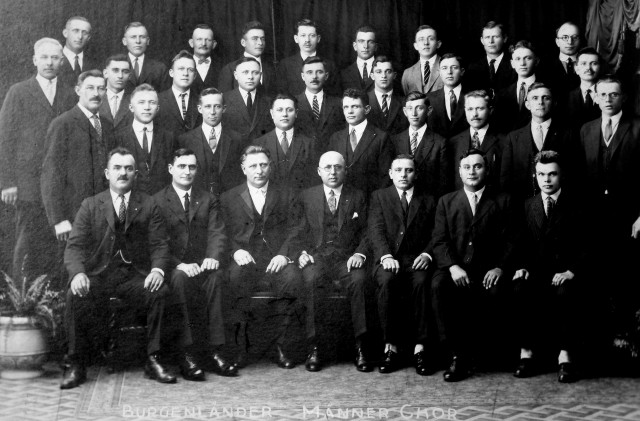 context,
we are planning an exhibit, a video clip, a commemorative booklet as well as events throughout
the year circling around this anniversary." The message went on to say that they were
collecting images for use in the exhibit, video and booklet and would like to use one that
appeared in our 2008 Christmas newsletter.
context,
we are planning an exhibit, a video clip, a commemorative booklet as well as events throughout
the year circling around this anniversary." The message went on to say that they were
collecting images for use in the exhibit, video and booklet and would like to use one that
appeared in our 2008 Christmas newsletter.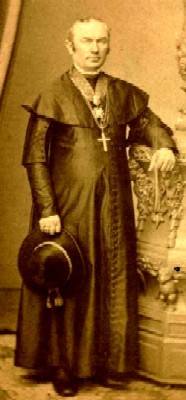 Hungarian:
Osztovics György
Hungarian:
Osztovics György